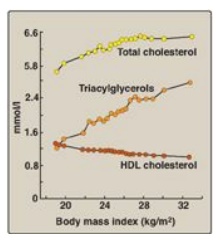Metabolic Changes In Obesity
| Home | | Biochemistry |Chapter: Biochemistry : Obesity
The primary metabolic effects of obesity include dyslipidemias, glucose intolerance, and insulin resistance expressed primarily in the liver, muscle, and adipose tissue.
METABOLIC CHANGES IN OBESITY
The primary metabolic effects of obesity include dyslipidemias, glucose intolerance, and insulin resistance expressed primarily in the liver, muscle, and adipose tissue. These metabolic abnormalities reflect molecular signals originating from the increased mass of adipocytes. (see Figure 25.7 and Figure 26.7)

Figure 26.7 Some signals that influence appetite and satiety. CCK = cholecystokinin, PYY = peptide YY.
A. Metabolic syndrome
Abdominal obesity is associated with a cluster of metabolic abnormalities that is referred to as the metabolic syndrome and includes glucose intolerance (hyperglycemia below that classified as diabetes;), insulin resistance, hyperinsulinemia, dyslipidemia (low levels of high-density lipoprotein and elevated TAGs), and hypertension (Figure 26.8). The metabolic syndrome is also associated with a state of low-grade, chronic, systemic inflammation that contributes to the pathogenesis of insulin resistance and atherosclerosis. In obesity, adipocytes release proinflammatory mediators such as IL-6. Additionally, low levels of the adipocyte hormone adiponectin that normally dampens inflammation and sensitizes tissues, especially the liver, to insulin, may contribute to the metabolic syndrome and, therefore, the risk of T2D and heart disease.

Figure 26.8 Body mass index
and changes in blood lipids. HDL= high-density lipoprotein.
Related Topics
